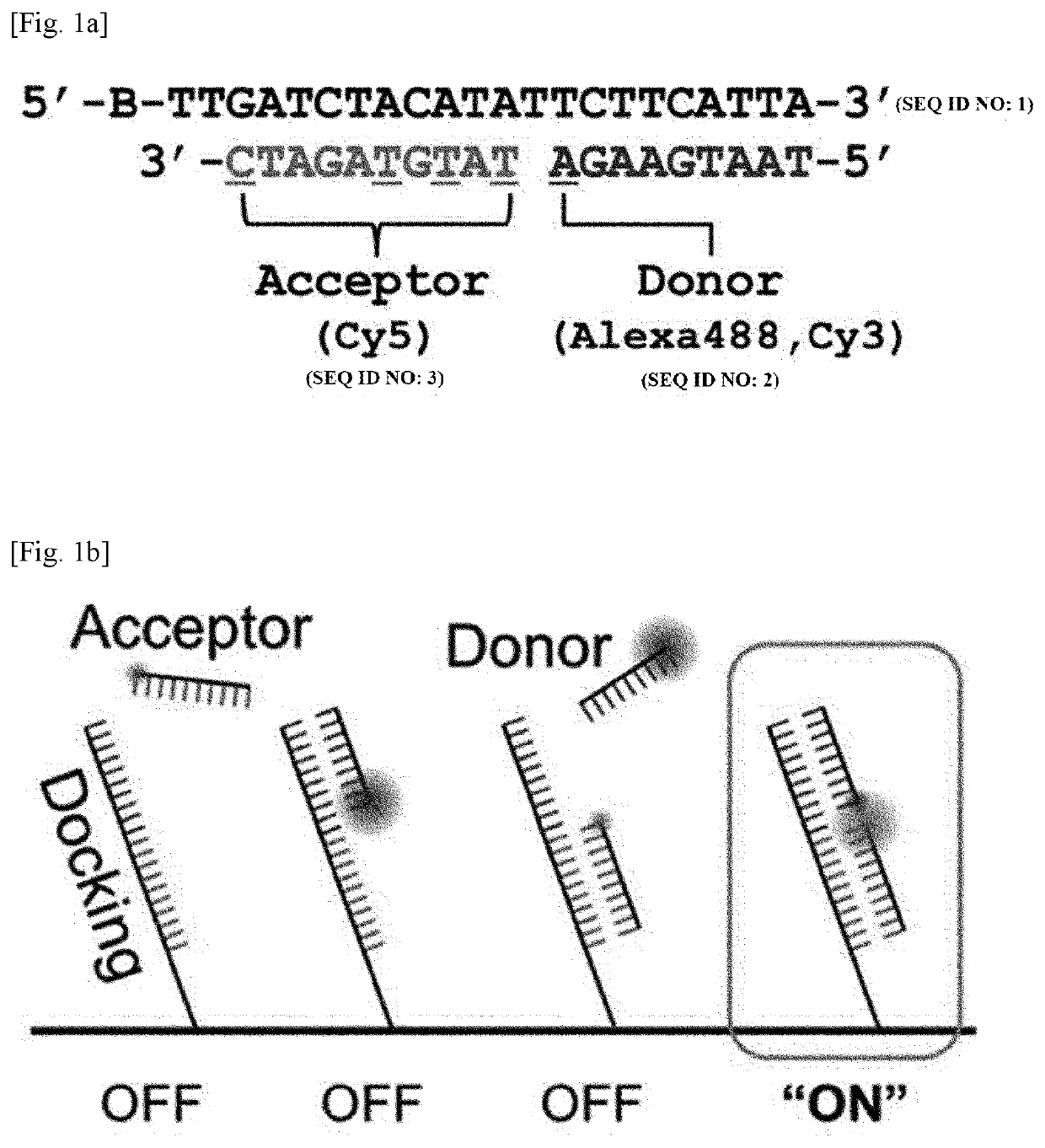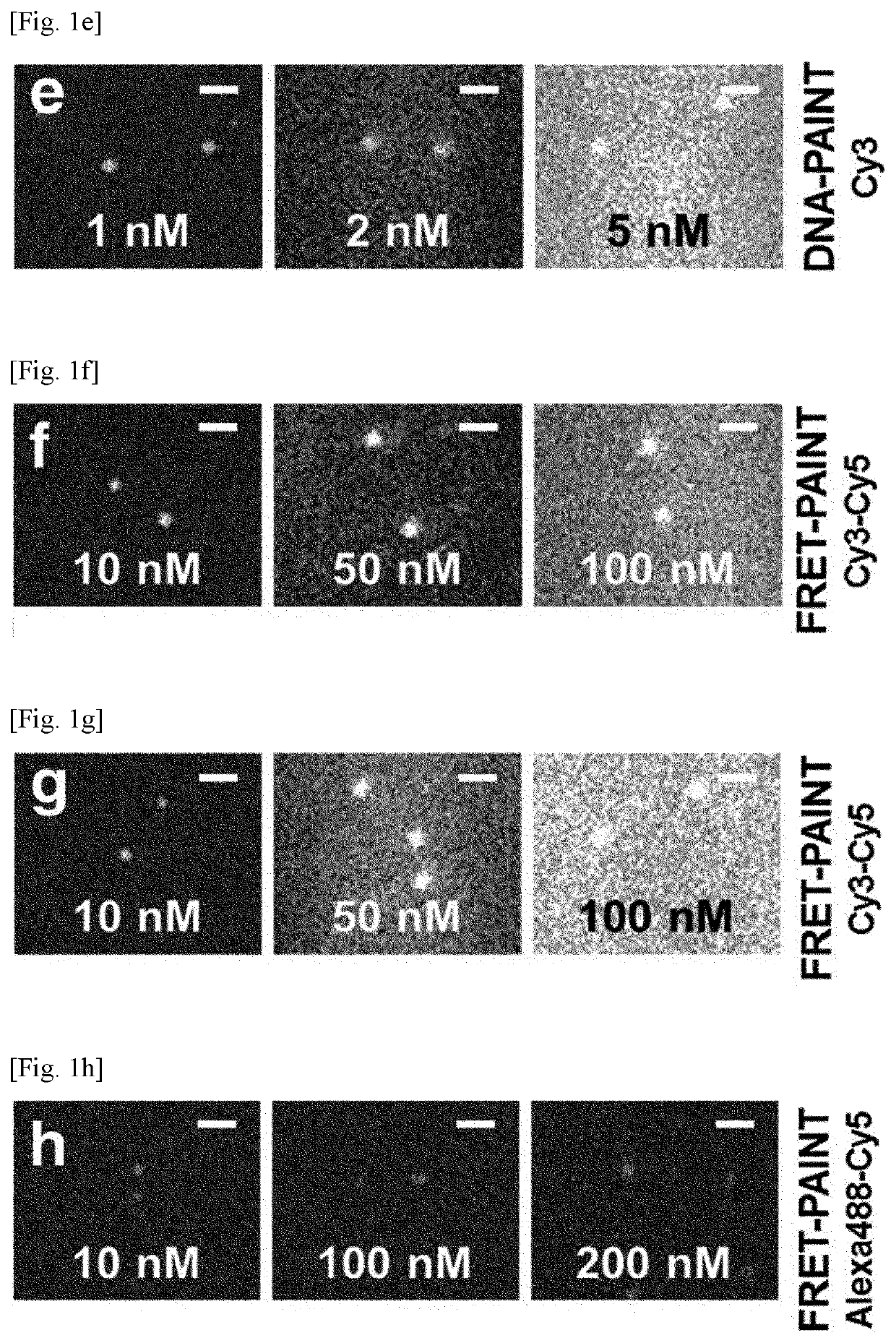Ultrasensitive method for multiplexed detection of biomarkers
a biomarker and multiplexing technology, applied in the field of ultrasensitive methods for multiplexing detection of biomarkers, can solve the problems of imposing mental and physical burdens on subjects, unable to use multiplexing detection based on a single biomarker, and unable to accurately diagnose the level of only one biomarker
- Summary
- Abstract
- Description
- Claims
- Application Information
AI Technical Summary
Benefits of technology
Problems solved by technology
Method used
Image
Examples
example 1
ization of FRET-PAINT
[0114]Surface-immobilized DNA strands and a TIRF microscope were used to test the feasibility of FRET-PAINT microscopy.
[0115]As shown in FIG. 1a, FRET-PAINT used three DNA strands (docking, donor, and acceptor strands). The docking strand (Docking_P0) labeled with a biotin at the 5′-end has two docking sites, each of which base-pairs with the donor or acceptor strand. To increase the FRET probability, a shorter length for the donor strand than for the acceptor strand was chosen whereas relatively longer acceptor strand was used. The donor strand was labeled at the 3′-end with Alexa488 (Donor_P1_Alexa488) whereas the acceptor strand was labeled with Cy5 (Acceptor_P11_Cy5) at the 3′-end.
[0116]The sequences of the strands are as follows:
(SEQ ID NO: 1)Docking_PO = 5′-Biotin-TTGATCTACATATTCTTCATTA-3′(SEQ ID NO: 2)Donor_P1_Cy3 - 5′-TAATGAAGA-Cy3-3′(SEQ ID NO: 2)Donor_P1_Alexa488 = 5′-TAATGAAGA-Alexa488-3′(SEQ ID NO: 3)Acceptor_P2_Cy5 = 5′-Cy5-TATGTAGATC-3′(SEQ ID NO: ...
example 2
lution Imaging with DNA-PAINT and FRET-PAINT
[0124]The following experimental procedure was performed to compare the super-resolution imaging speeds of DNA-PAINT and FRET-PAINT.
[0125]First, microtubules of COS-7 cells were immunostained with the anti-tubulin antibody which is labeled with Docking_P1.
[0126]Then, for DNA-PAINT, microtubules were imaged after injecting 1 nM Cy5-labeled imager strand (Acceptor_P2′_Cy5). For FRET-PAINT, microtubules of the same area were imaged after injecting 30 nM donor (Donor_P1_Alexa488) and 20 nM acceptor (Acceptor_P2_Cy5) strands. Single-molecule images were recorded at a frame rate of 10 Hz, which is fast enough to reliably detect binding of donor and acceptor strands.
[0127]To quantitatively compare the imaging speed of DNA-PAINT and FRET-PAINT, the number of spots of FIGS. 2a and 2b was measured. The same analysis was performed for nine additional imaging areas and the averaged speeds were compared. The convolved resolutions computed as ((localiza...
example 3
T Multiplexed Imaging
[0130]The multiplexing capability of FRET-PAINT microscopy was assessed by the following experimental procedure.
[0131]Microtubules and mitochondria of COS-7 cells were immunostained using anti-tubulin antibody and anti-Tom20 antibody, respectively. The anti-tubulin antibody and anti-Tom20 antibody were orthogonally conjugated with Docking_P1 and Docking_P2, respectively. In the present invention, two approaches were used for multiplexed imaging.
[0132]The results are shown in FIGS. 3a to 3h. In the one approach shown in FIG. 3a (by sequential treatment with donor and acceptor strands), microtubules were first imaged by injecting 20 nM Donor_P1_Alexa488 and 10 nM Acceptor_P2_Cy5 (FIG. 3b) and mitochondria were then imaged by injecting 10 nM Donor_P2_Alexa488 and 10 nM Acceptor_P2_Cy5 (FIGS. 3c and 3d). In the second approach shown in FIG. 3e (by simultaneous treatment with donor and acceptor strands), after injection of all DNA probes (10 nM Donor_P1_Cy3 for micro...
PUM
| Property | Measurement | Unit |
|---|---|---|
| Ratio | aaaaa | aaaaa |
| Wavelength | aaaaa | aaaaa |
| Fluorescence | aaaaa | aaaaa |
Abstract
Description
Claims
Application Information
 Login to View More
Login to View More - R&D
- Intellectual Property
- Life Sciences
- Materials
- Tech Scout
- Unparalleled Data Quality
- Higher Quality Content
- 60% Fewer Hallucinations
Browse by: Latest US Patents, China's latest patents, Technical Efficacy Thesaurus, Application Domain, Technology Topic, Popular Technical Reports.
© 2025 PatSnap. All rights reserved.Legal|Privacy policy|Modern Slavery Act Transparency Statement|Sitemap|About US| Contact US: help@patsnap.com



